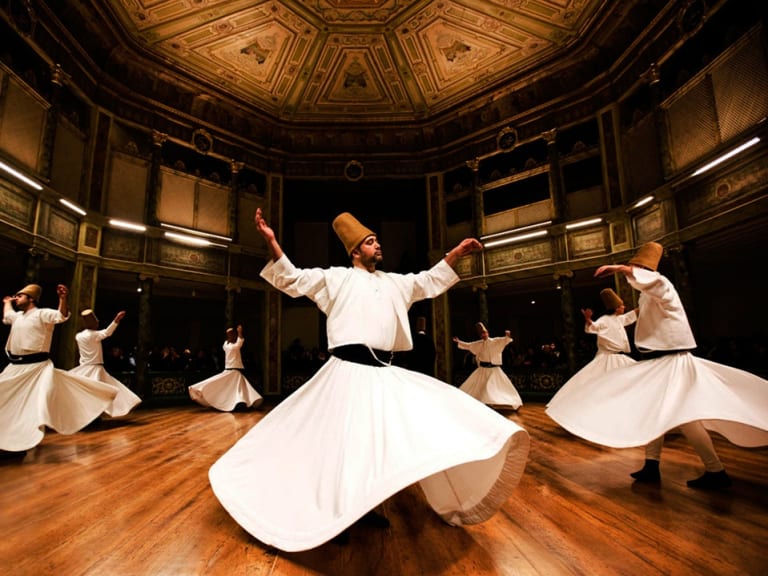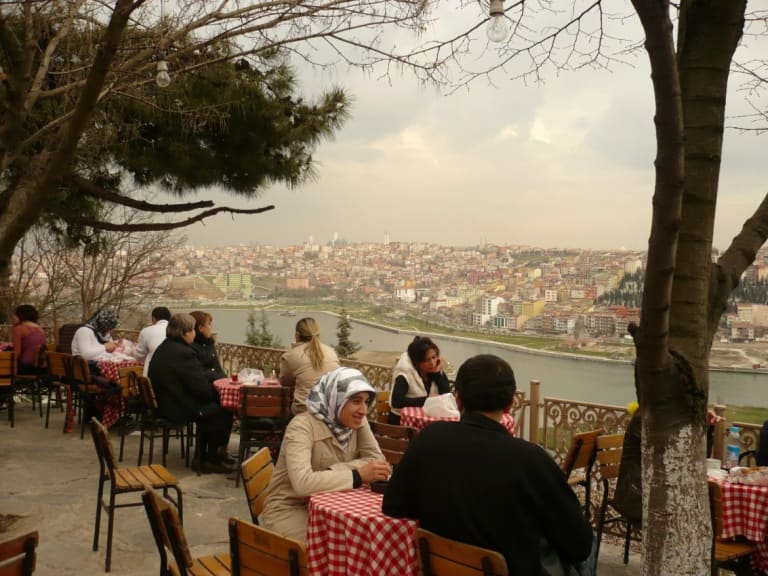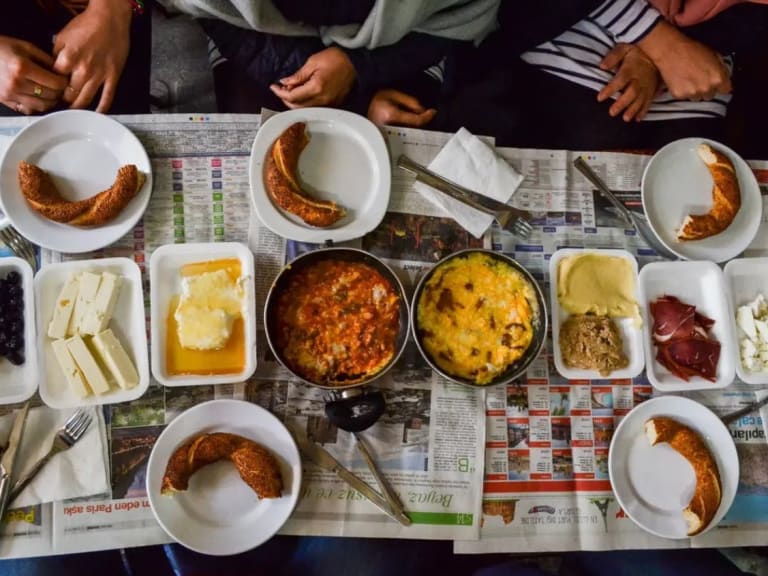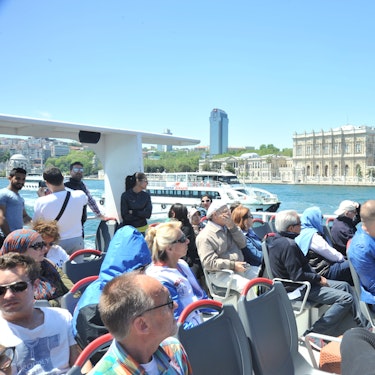More about: 12 Things to Do in Istanbul in the winter
One of the great advantages of travelling to Istanbul in winter is that you'll find the places less crowded with tourists and eventually you'll be able to visit the most important places in Istanbul ina quieter way than in summer, when the city is more crowded and even hotter.
The low season, which in this case runs from November to February, also means interesting discounts on flights and accommodation. Even better, you'll be able to experience Turkish culture, enjoy the friendliness of the locals and, by the way, get better prices in the city's bazaars and shops.
1. Experience the best of the Suni dance season

The beginning of winter in Istanbul is one of the best times of the year tobook tickets for the Whirling Dervishes. These are members of the Mevlevi order, the best known of the mystical ideology of Sufism and declared an Intangible Heritage of Humanity by UNESCO.
While the show is available in all seasons, December is the time for the Seb-i Arus, an important religious celebration of the Sufi tradition commemorating the death of the poet Muhammad Khalāl al-Dīn Rūmī|, considered one of the world's greatest Sufi philosophers.
You can also enjoy other exclusive activities on these dates such as workshops, talks and audiovisual exhibitions open to the public, to learn more about this very relevant spiritual and cultural manifestation in various parts of Turkey.
Useful information:
- This is a religious ritual. Out of respect for tradition, it is not polite to clap, take pictures or shout while the dancers are spinning.
- This show usually costs around €40 and includes admission, the whirling dervish ceremony and a concert of Sufi music. Many of these ceremonies are held at the iconic Hodjapasha Dance Theater in Istanbul.
- The city also offers other typical dance performances such as belly dancing and Cossack shows.
2. Take the tourist bus, and take shelter from the cold!

It is clear that the temperatures in the middle of winter in the city of Istanbul are very cold and this can be an impediment when it comes to sightseeing, walking through its streets, visiting all its emblematic sites... To make your days of walking and strolling in the cold a little easier, we suggest you book tickets on a tourist bus to take shelter from the cold, without missing anything!
You can hop on and off whenever you want for 24 hours on a route that consists of 12 stops. In addition, this trip includes an audio guide explaining in detail each monument and place you visit.
3. Enjoy a winter drink

The arrival of winter in the city comes with some classic recipes to beat the cold. One of the most popular in the season is Salep, a mixture of milk or boiling water, cinnamon and a special flour obtained by carefully processing the tubers of two typical Anatolian orchids.
Another favourite drink that is only available in winter is Boza, a drink made by fermenting the seeds of breadfruit, a cereal widely consumed in Asian countries, and served with a sprinkling of cinnamon powder on top and accompanied by roasted chickpeas. Istanbul is also famous for tea rooms with a huge menu of hot herbal teas and the famous Turkish coffee which is sold on every street corner in the city.
4. Take a trip to Cappadocia, complete with hot air balloon ride!

One of the most impressive excursions to do around Istanbul is to visit Cappadocia. This is one of the places you have to visit at least once in your life. It is made up of valleys, rocky mountains sculpted by the wind in a magical way and even mysterious underground cities.
If you have decided to book a tour to Cappadocia, you will spend two days learning all about the culture and history of the area, visit some of the main sites such as: Uchisar Castle, Goreme open air museum and the underground city of Derinkuyu and best of all, enjoy a hot air balloon ride! Hotel accommodation and breakfast are included and all for around €600.
5. Visit a Turkish cafe and play tavla ("backgammon")

Nothing beats a hot coffee and a game of backgammon to keep you warm in the cold. In Turkey, backgammon is the national board game and is known as tavla. In winter you will see the cafés and bars full, and their customers playing rounds of this game which is designed for two people and where the aim is to get checkers off the board before your opponent.
According to historians, tavla originated in Mesopotamia, from where it spread to the rest of the world. If you don't know how to play, you can ask the waiters and other customers, who will be happy to explain the rules and, why not, invite you to play a game. It is very traditional to play after dinner, while your tea or coffee is being served. One of the most recommended places for a good winter dinner is Mesale Café, where you can also enjoy musical shows and the best of Turkish food.
If you just want to have a coffee to raise the temperature, remember that Istanbul' s coffee culture is world-renowned and you will find the best places to have an authentic Turkish coffee in Beyoglu. I recommend it!
6. Enjoy a Turkish bath

Visiting one of the famous Turkish baths in Istanbul is undoubtedly a perfect experience to rest and recharge your batteries, enjoy a massage, sip a comforting tea and keep warm to continue touring the city.
This ancient tradition takes you through absolutely relaxing enclosures where you will have a deep cleansing of body and mind. In Istanbul there are Turkish baths exclusively for men and others for women, although you can also find options for mixed baths. You can find tours that offer this experience with prices starting at around €35, which includes entrance, tea and in some cases massages. Highly recommended!
7. Turn up the heat by sampling the best of the local cuisine

Warm up by taking a gastronomic tour of Istanbul through traditional and delicious Turkish street food stalls, enjoying seasonal soups, stews and drinks, listening to stories of old fishermen on the Galata Bridge and getting to know the soul of this transcontinental city.
8. Visit a mosque

Indoor plans are our favourite during the winter and visiting a mosque is a plan I recommend to include in this season to learn more about the history and religious tradition of this magical destination.
It is definitely a worthwhile cultural exchange experience. In addition, the Muslim religion in this country is much more flexible and tolerant, so you will have no problem visiting some of the best mosques in Istanbul.
One of the ones I recommend the most is Hagia Sophia. It was the largest church in the Christian world, the main mosque in Istanbul for almost 4 centuries, later converted into a museum; and since 2020, made into a mosque again.
Some other mosques you can visit are:
- Blue Mosque (Sultan Ahmet Camii).
- New Mosque (Yeni Camii).
- Rüstem Pasha Camii (Rüstem Pasha Camii).
- Eyüp Sultan Mosque (Eyüp Sultan Camii).
9. Enjoy a day of shopping and take advantage of the seasonal sales

If you are visiting Istanbul in January or February, I recommend you to take advantage of the sales season in the local shops. Besides the fact that visiting a shopping mall can be a good way to protect yourself from the cold, you can find discounts on clothing, accessories and much more.
The winter sales in Istanbul start in mid-December and run until the end of February, with discounts of up to 50%. There are more than 200 trendy shopping malls in the city. I recommend visiting Kanyon, Vadistanbul and Akaysha.
Bazaars and street markets also have sales. The weekend markets in Besiktas, Bakirkoy and Ferikoy on the European side and the Kadikoy market on the Asian side are well worth a visit. In winter many of them are covered, so the cold won't stop you from bargaining for the best seasonal shopping.
10. Make the most of the harvest and try the national fruit: the pomegranate

Between September and February, the national fruit is harvested: the pomegranate, a favourite fruit from the Middle East. Along with dates, it is one of the most famous edibles in the winter season and is enjoyed in many forms: juice, as an aromatic infusion, in salads and yoghurt, or in various desserts and culinary preparations typical of the country.
It is a symbol of abundance and prosperity in Turkish idiosyncrasy and it is common to find pomegranate-shaped amulets, adorned with ribbons and nazar boncuğu pebbles, which according to locals ward off the evil eye and negative energies.
Useful information:
- A good way to sample this fruit is to visit the bazaars around the city. Don't miss the opportunity to bargain Turkish-style for amulets and souvenirs, or try a juice of this exotic fruit on a guided tour of Istanbul's Grand Bazaar.
- Another famous talisman is the nazar boncuğu, better known as the Turkish eye, made of coloured crystals and which, according to local tradition, ward off bad vibes. It can be a nice gift for someone you care about on your return, or a curious decorative object for your home.
11. Enjoy a ski slope near Istanbul

Although Istanbul is famous for its monuments, history and tradition, you might be surprised to learn that it also has a lot to offer snow and ski lovers. If you can find enough time during your trip, I recommend exploring some of the ski areas close to Istanbul and easily accessible by air and road.
One of the most popular and recommended places to visit is the Uludağ resort, where you can arrive via ferry to the port of Bursa and from there take a car for about two hours. In this area you will find several hotels and an ideal environment to enjoy the snow. In the resort you will find 20 slopes and differentiated areas for different levels of difficulty, as well as sledges, snow bikes and snowboards.
If after skiing you want to refresh yourself, only an hour away from the slopes you will find an incredible hot springs.
12. Protect yourself from the cold at the Ara Güler Museum

Also known as the eye of Istanbul, Ara Güler is considered one of the best photographers in the world.A correspondent for major world magazines such as Time, Life and Newsweek, throughout his life he photographed the most remote places in countries such as India, Kenya, New Guinea and Afghanistan and celebrities such as Winston Churchill, a very young Sophia Loren, Salvador Dalí and Marlon Brando, among others.
But undoubtedly the most valuable aspect of his work is his particular sensitivity for eternalising the essence of people through his lens and capturing thousands of images of Istanbul in more than 60 years of career that allow us to review the modern history of the city through his eyes.
A tour of a couple of hours that you can alternate with a visit to the already well-known emblems of the city, such as the Blue Mosque, Hagia Sophia or the Topkapi Palace.
Useful information
- Price: free of charge
- Opening hours: Tuesday to Saturday from 10:00 to 18:00, Sunday from 12:00 to 18:00.
- Address: Ara Güler Müzesi, Yapı Kredi Bomontiada, Ara Güler Müzesi Tarihi Bomontiada Bira Fabrikası, Birahane Sk. No:1, 34381 Şişli, Turkey.
Temperatures in Istanbul during winter

During the winter in Istanbul you won't experience freezing temperatures, so you'll be able to explore the city without any problems and you'll only have to protect yourself from a few rainy days, when snow may even fall. Temperatures during this season hover around 11°C / 5°C.
What to pack for the season

When faced with the questions "What should I bring?" or "What should I put in this suitcase?", it is important to think a little about the list of essentials that will make your life easier if you travel in winter.
First of all, bring good, comfortable shoes, preferably non-slip, that will allow you to walk safely on wet platforms and frozen slabs. Scarf, gloves, hat, a compact umbrella and other winter classics will be welcome to keep you warm.
You don't need to bring your whole wardrobe or many coats, one good one is enough. We recommend comfortable woollen jumpers for a long walk in the Bosphorus and very important: clean socks as it is compulsory to take off your shoes to enter the mosques.




